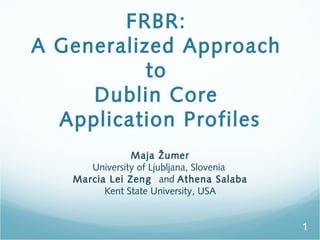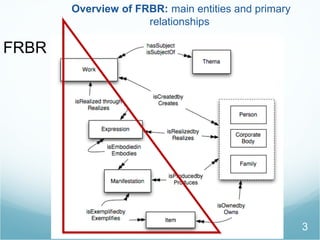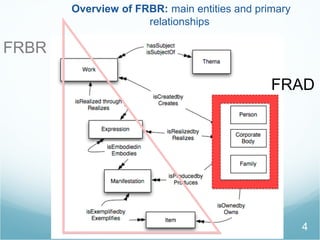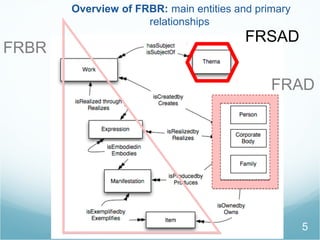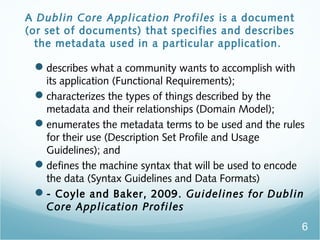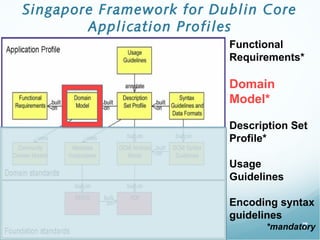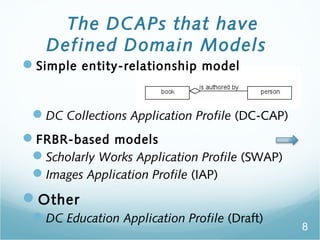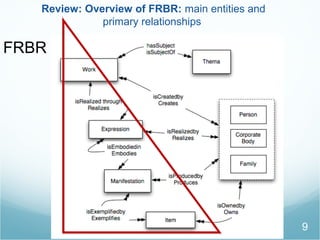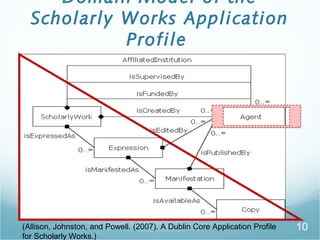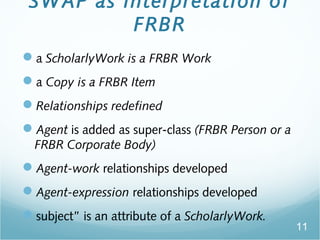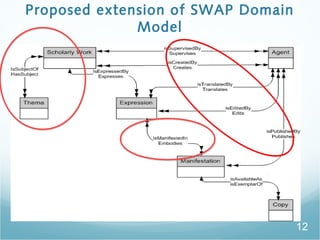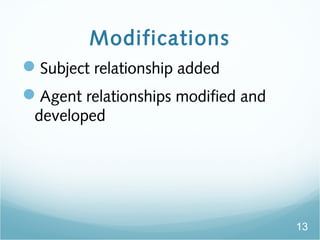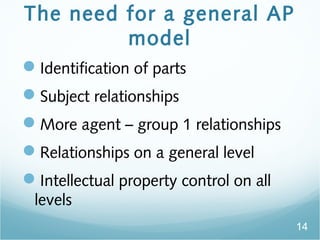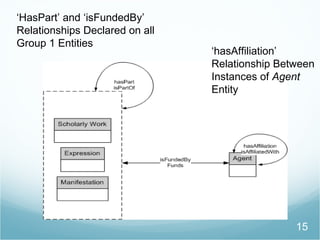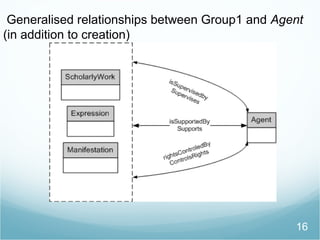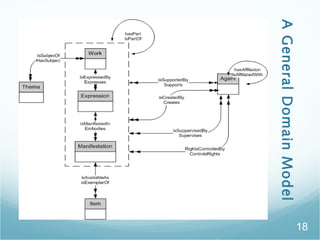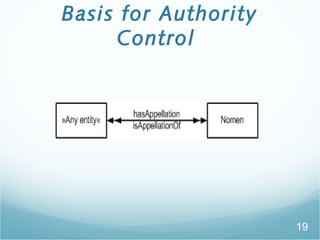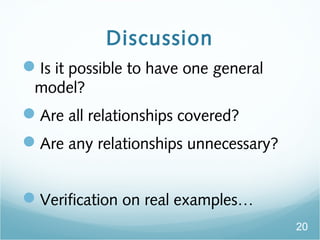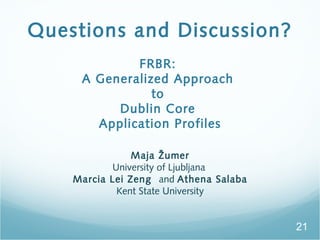FRBR: A Generalized Approach to Dublin Core Application Profiles
- 1. FRBR: A Generalized Approach to Dublin Core Application Profiles Maja ?umer University of Ljubljana, Slovenia Marcia Lei Zeng and Athena Salaba Kent State University, USA 1
- 2. 2 Overview of FRBR: main entities and primary relationships
- 3. 3 Overview of FRBR: main entities and primary relationships FRBR
- 4. 4 Overview of FRBR: main entities and primary relationships FRBR FRAD
- 5. 5 Overview of FRBR: main entities and primary relationships FRBR FRAD FRSAD
- 6. A Dublin Core Application Profiles is a document (or set of documents) that specifies and describes the metadata used in a particular application. ?describes what a community wants to accomplish with its application (Functional Requirements); ?characterizes the types of things described by the metadata and their relationships (Domain Model); ?enumerates the metadata terms to be used and the rules for their use (Description Set Profile and Usage Guidelines); and ?defines the machine syntax that will be used to encode the data (Syntax Guidelines and Data Formats) ?- Coyle and Baker, 2009. Guidelines for Dublin Core Application Profiles 6
- 7. Singapore Framework for Dublin Core Application Profiles 7 Functional Requirements* Domain Model* Description Set Profile* Usage Guidelines Encoding syntax guidelines *mandatory
- 8. The DCAPs that have Defined Domain Models ?Simple entity-relationship model ?DC Collections Application Profile (DC-CAP) ?FRBR-based models ?Scholarly Works Application Profile (SWAP) ?Images Application Profile (IAP) ?Other ?DC Education Application Profile (Draft) 8
- 9. 9 Review: Overview of FRBR: main entities and primary relationships FRBR
- 10. Domain Model of the Scholarly Works Application Profile 10(Allison, Johnston, and Powell. (2007). A Dublin Core Application Profile for Scholarly Works.)
- 11. SWAP as interpretation of FRBR ?a ScholarlyWork is a FRBR Work ?a Copy is a FRBR Item ?Relationships redefined ?Agent is added as super-class (FRBR Person or a FRBR Corporate Body) ?Agent-work relationships developed ?Agent-expression relationships developed ?subjectˇ± is an attribute of a ScholarlyWork. 11
- 12. Proposed extension of SWAP Domain Model 12
- 13. Modifications ?Subject relationship added ?Agent relationships modified and developed 13
- 14. The need for a general AP model ?Identification of parts ?Subject relationships ?More agent ¨C group 1 relationships ?Relationships on a general level ?Intellectual property control on all levels 14
- 15. 15 ˇ®HasPartˇŻ and ˇ®isFundedByˇŻ Relationships Declared on all Group 1 Entities ˇ®hasAffiliationˇŻ Relationship Between Instances of Agent Entity
- 16. 16 Generalised relationships between Group1 and Agent (in addition to creation)
- 17. Relationships ?Supervision (examples) ?Advisor ?Chief investigator ?Support (examples) ?Funding/partial funding ?Non-material support ?Intellectual rights control 17
- 20. Discussion ?Is it possible to have one general model? ?Are all relationships covered? ?Are any relationships unnecessary? ?Verification on real examplesˇ 20
- 21. Questions and Discussion? FRBR: A Generalized Approach to Dublin Core Application Profiles Maja ?umer University of Ljubljana Marcia Lei Zeng and Athena Salaba Kent State University 21
Editor's Notes
- #8: The Guidelines for Dublin Core Application Profiles document provides a framework for the content and structure of any Dublin Core Application Profile (DCAP). The document explains the key components of a Dublin Core Application Profile and walks through the process of developing a profile. According to these guidelines, ˇ°[a] DCAP is a document (or set of documents) that specifies and describes the metadata used in a particular application. To accomplish this, a profile: describes what a community wants to accomplish with its application (Functional Requirements); characterizes the types of things described by the metadata and their relationships (Domain Model); enumerates the metadata terms to be used and the rules for their use (Description Set Profile and Usage Guidelines); and defines the machine syntax that will be used to encode the data (Syntax Guidelines and Data Formats)ˇ± (Coyle and Baker, 2009).
- #9: Several DCAPs have been developed throughout the years. The main points of reference for the review criteria applied to application profiles are the Singapore Framework for Dublin Core Application Profiles, the DC Abstract Model and a draft Description Set Profile specification (Mikael, 2008). Here we introduce a few best-practice examples of application: Dublin Core Collections Application Profile (DC-CAP), published in March 2007, specifies how to construct a DC metadata description set that provides a collection level description. It provides a means for creating simple descriptions of collections (i.e., aggregations of physical or digital resources), as well as simple descriptions of catalogues and indexes (i.e., aggregations of the metadata that describe the collections). It employs a simple entity-relationship model for collections and their relationships to other entities. The entities are: Collection -- An aggregation of Items. Item -- A physical or digital resource. Location -- A place where a Collection is held. Service -- A system that provides access to the Items within the Collection. Catalogue or Index -- An aggregation of Items, which describes a Collection. The DC Collections AP describes the use of properties to represent attributes of the Collection and of the Catalogue or Index as well as relationships between or among the entities Collection and Catalogue or Index. Another entity, Agent, is also presented in the context of the model but is not further defined (Dublin Core Collection Description Task Group, 2007). The Scholarly Works Application Profile (SWAP) was developed in 2006 and reviewed by the DCMI Usage Board in 2009 in order to provide a method for describing scholarly works. A Scholarly Work is defined as a distinct intellectual or artistic scholarly creation. The model comprises of the following five entities: Scholarly Work Expression Manifestation Copy Agent (Allison et al., 2007). This application profile provides a way of describing these entities as part of a description set (a set of related DC descriptions). Details of this domain model will be discussed in Section 2 below. The Images Application Profile (IAP), a DCAP, came out from the work undertaken within the JISC Digital Repositories programme (UK) for describing images held in institutional repositories. The research concluded that FRBR could be used quite successfully to model some image types, particularly those that are the product of an artistic or intellectual process. However, the group found that the Expression entity is not applicable to all types of images and therefore a decision was made to exclude Expression from IAP domain model. According to IAP, any change in an image produces a new Manifestation. The group considered the possible consequences as IAP merges with other related FRBR-based repository profiles (Images Application Profile, 2008).
- #10: DC-SWAP focuses on e-prints (including scholarly works, research papers or scholarly research texts), particularly for the purpose of repositories and aggregator services. In the initial stages, the DC-SWAP working group specified the goals of the application profile. (Eprints Application Profile Functional Requirements Specification, 2006). At that time, FRAD and FRSAD were not developed yet. As seen in Figure 2, the DC-SWAP model is based on FRBR with some modifications, particularly in labels for entities and relationships (Allison, et al., 2007).
- #11: According to the SWAP Application Model presented by Allison, et al. (2007), it can be summarized that SWAP has introduced the following changes to FRBR: a ScholarlyWork is a FRBR Work a Copy is a FRBR Item an Agent is a FRBR Person or a FRBR Corporate Body the ˇ®isExpressedAsˇŻ relationship is known as ˇ®is realized throughˇŻ in FRBR the ˇ®isManifestedAsˇŻ relationship is known as ˇ®is embodied inˇŻ in FRBR the ˇ®isAvailableAsˇŻ relationship is known as ˇ®is exemplified byˇŻ in FRBR the ˇ®isCreatedByˇŻ relationship is known as ˇ®is created byˇŻ in FRBR the ˇ®isPublishedByˇŻ relationship is modelled as the ˇ°publisherˇ± attribute of a Manifestation in FRBR.
- #13: Some differences need to be pointed out: All relationships are declared in both directions, left-to-right first. The arrows are indicating the cardinality of the relations, in line with FRBR conventions. The most important change is the relationship between Expression and Manifestation: in addition to the obvious fact that any instance of Expression can be embodied in (ˇ®isManifestedInˇŻ) one or more Manifestations, we need to point out that any instance of Manifestation may embody one or more instances of Expressions. Examples of Manifestations embodying more Expressions include texts with illustrations, a journal issue, or any collection of articles. Here the relationship label has been changed from ˇ®isManifestedAsˇŻ to ˇ®isManifestedInˇŻ to reflect the situation. The ˇ®hasSubjectˇŻ relationship from Work to Thema is added. In SWAP ˇ°subjectˇ± is an attribute of a ScholarlyWork.
- #19: A general DCAP domain model is needed for ensuring the interoperability of all application profiles and metadata created using these APs. A general AP domain model will not cover all specific tasks or specific features of the different forms/genre/types of resources. These special needs are, and should be, taken care of in specific APs. The General DCAP Domain Model (Figure 6) is proposed based on previous developments. In The General DCAP Domain Model, the relationships are declared on the most general level; any particular AP will then define more specific relationships, for example ˇ®isFundedByˇŻ could replace ˇ®isSupportedBy.ˇŻ Similarly the general ˇ®isCreatedByˇŻ can be refined as ˇ®isTranslatedByˇŻ (in the case of Expression) or ˇ®isPublishedByˇŻ for Manifestation. ?

